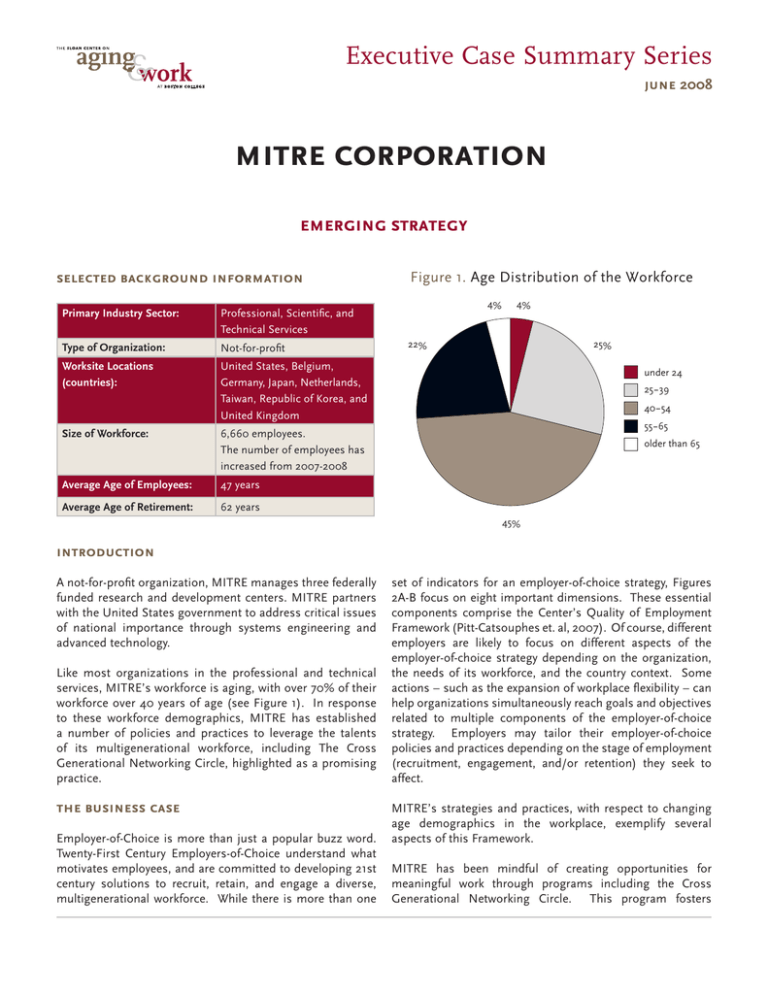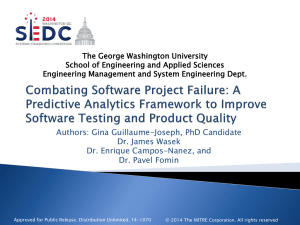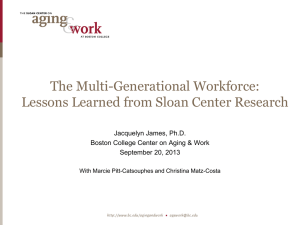mitre corporation Executive Case Summary Series emerging strategy Figure 1.
advertisement

Executive Case Summary Series june 2008 mitre corporation emerging strategy selected background information Primary Industry Sector: Professional, Scientific, and Technical Services Type of Organization: Not-for-profit Worksite Locations (countries): United States, Belgium, Germany, Japan, Netherlands, Taiwan, Republic of Korea, and United Kingdom 6,660 employees. The number of employees has increased from 2007-2008 Average Age of Employees: 47 years Average Age of Retirement: 62 years 4% 4% 22% 25% under 24 25-39 40-54 55-65 older than 65 45% introduction A not-for-profit organization, MITRE manages three federally funded research and development centers. MITRE partners with the United States government to address critical issues of national importance through systems engineering and advanced technology. Like most organizations in the professional and technical services, MITRE’s workforce is aging, with over 70% of their workforce over 40 years of age (see Figure 1). In response to these workforce demographics, MITRE has established a number of policies and practices to leverage the talents of its multigenerational workforce, including The Cross Generational Networking Circle, highlighted as a promising practice. the business case Employer-of-Choice is more than just a popular buzz word. Twenty-First Century Employers-of-Choice understand what motivates employees, and are committed to developing 21st century solutions to recruit, retain, and engage a diverse, multigenerational workforce. While there is more than one set of indicators for an employer-of-choice strategy, Figures 2A-B focus on eight important dimensions. These essential components comprise the Center’s Quality of Employment Framework (Pitt-Catsouphes et. al, 2007). Of course, different employers are likely to focus on different aspects of the employer-of-choice strategy depending on the organization, the needs of its workforce, and the country context. Some actions – such as the expansion of workplace flexibility – can help organizations simultaneously reach goals and objectives related to multiple components of the employer-of-choice strategy. Employers may tailor their employer-of-choice policies and practices depending on the stage of employment (recruitment, engagement, and/or retention) they seek to affect. MITRE’s strategies and practices, with respect to changing age demographics in the workplace, exemplify several aspects of this Framework. MITRE has been mindful of creating opportunities for meaningful work through programs including the Cross Generational Networking Circle. This program fosters 1 The Sloan Center on Aging & Work at boston college Executive Case Summary Size of Workforce: % of Employees by Age Figure 1. Age Distribution of the Workforce Bridging the Gap Focus Group Findings Figure 2a. Quality of Employment: Strategy February 16-17, 2005 Opportunities for Development, Learning & Advancement ÂÂ Found a need to form cross-generational networks ÂÂ Networks create opportunities for cross-generational networking and development Rewards; Fair, Attractive and Competitive Compensation & Benefits ÖÖ Exchange of knowledge and advice ÖÖ Promote leadership and professional development ÖÖ Provide members insight into leadership perspectives a culture of respect, inclusion and equity, and promotes constructive relationships at the workplace. The networking circle also creates opportunities for development, learning and advancement for employees through the discussion of a wide range of participant selected topics. Aspects of the Quality of Employment Framework demonstrated by MITRE are fostered through additional company programs such as flexible work arrangements, and Retirees at the Ready. Recruitment At present, only 5% of the company’s annual hires are recent college graduates; 60% are above the age of 40; and 7% are rehires. MITRE feels that it needs to improve its ability to recruit younger generations “in order to have a viable organization in the future.” Recruitment is particularly challenging for MITRE because their talent pool is limited. MITRE must hire United States citizens who can obtain clearance to work with the government, but most college students in technical programs are not from the United States. Retention The retention of younger generations has been an additional challenge for MITRE. Of those who terminate annually from MITRE, 70% have fewer that 5 years with the company. While the overall rate of turnover is low (~5%), MITRE recognized that individuals with 3-5 years experience were leaving at a higher rate than their mid-career counterparts. MITRE is currently exploring options such as the Cross Generational Networking Circle to help increase the retention of younger workers. Workplace Flexibility MITRE considers workplace flexibility to be a core strength and integral part of it’s overall work/life strategy. For the Opportunities for Meaningful Work (at and outside of the workplace) Quality of Employment Provisions for Employability and Employment Predictabilities Workplace Flexibility Culture of Respect, Inclusion, and Equity past 7 years, they have been rated 6 – 8 percentage points above average on the Fortune 100 Best Companies list. The company hopes to leverage this strength as they move forward with a comprehensive multigenerational strategy. Knowledge Transfer MITRE is beginning to address threats of knowledge loss that could be exacerbated by projections of employees who may soon retire, potentially with no one in place to assume their responsibilities. For example, MITRE has many radar engineers who are over 55, but there are few younger people entering that field to replace those workers when they retire. the response Although a formalized strategy has not yet been developed, MITRE has many initiatives in place. MITRE is committed to developing a more strategic response to the changing age demographics of their workforce. In response to the previously discussed issues, MITRE is beginning to set the correct expectations for workplace flexibility and think about ways in which it can leverage its older workers to attract, engage, and retain younger generations, such as through mentoring programs. MITRE has formed diversity committees and subcommittees to deal with generational issues within the company. The company has also surveyed employees regarding their awareness of diversity issues. A high percentage of employee respondents indicated that generational diversity will be an important challenge over the next five years. MITRE also formed focus groups, including “Bridging the Gap,” with the goal of gaining insight into how different generations of employees view the MITRE culture. The findings indicated that there could be benefits to establishing cross-generational networks and processes for better integration of new staff. As a result, MITRE has piloted the Cross Generational Networking Circle, which will be the 2 focus of the following section. The Sloan Center on Aging & Work at boston college Executive Case Summary MITRE wants to maintain its position as an employer-of-choice by assessing how to strengthen its approach to recruiting and retaining its multigenerational workforce. It also hopes to improve its ability to provide opportunities for flexibility and knowledge transfer. Promotion of Constructive Relationships at the Workplace Wellness; Health & Safety Protections promising practice featured promising practice at-a-glance Figure 2b. Quality of Employment: Practice Cross Generational Networking Circle Description: Purpose: Facilitated monthly meetings to discuss cross generational issues of interest to group members. Opportunities for Development, Learning & Advancement To promote development opportunities, leadership, and multi-directional knowledge transfer through professional and social networking among employees of different generations and career stages. Target Population: Employees at the Bedford, MA worksite. Members of the Networking Circle are nominated by their managers. Launch Date: September 2006 Rewards; Fair, Attractive and Competitive Compensation & Benefits Promotion of Constructive Relationships at the Workplace Wellness; Health & Safety Protections Opportunities for Meaningful Work (at and outside of the workplace) Quality of Employment Provisions for Employability and Employment Predictabilities Workplace Flexibility Culture of Respect, Inclusion, and Equity implementation MITRE wanted to create a group that was diverse, for example, by gender, race, age, and job function. Managers recommend employees for membership in the Cross Generational Networking Circle. Employees recommended for membership should have the time to commit to the pilot and be respected by senior staff. The Cross Generational Networking Circle, which consists of approximately 8-10 people, meets during lunch once a month. The discussions are led by a facilitator who sets ground rules and expectations, helps to move the discussions along, and encourages member participation. Although the Diversity Committee devoted significant time to the planning of the first meeting, there are no specific guidelines for the structure of the meetings. Facilitators are expected to work with the Generational Subcommittee to assess the Networking Circle pilot. Members take turns coordinating the meetings. They also make recommendations about the topics of future meetings. Some examples of topics are reporting to multiple people, collaboration versus competition, building networks, and MITRE values and goals. lessons learned After implementing the Cross Generational Networking Circles pilot, MITRE learned a variety of lessons that will be useful for the development of future practices. Some of these lessons are as follows: ÂÂ Size matters in terms of having enough people attend every meeting to have rich and meaningful discssions with a variety of perspectives. ÂÂ It takes time to “get things started.” ÂÂ Having senior staff champion the project is critical to its implementation. ÂÂ Name of the pilot mattered. Originally called “Mentoring Circles,” the pilot was renamed so that members would not think there was an expectation that they would have to assume mentoring responsibilities and to convey the message that all members were “on an equal footing.” ÂÂ It was important to elevate conversations about generational diversity so that it becomes a “burning platform” in the company. 3 The Sloan Center on Aging & Work at boston college Executive Case Summary The Cross Generational Networking Circle was launched as a pilot in September 2006 to create opportunities for professional and social networking which would encourage the multi-directional transfer of knowledge and promote leadership as well as professional development. evidence of progress MITRE feels that the program has had a positive impact on the company and its employees for a variety of reasons. Here are a few examples of the successes of the program: ÂÂ The Networking Circles have helped to retain some employees who might have otherwise left the company. ÂÂ One member solicited advice from other Networking Circle members about a presentation and was subsequently able to secure funding for the project. ÂÂ Networking Circle members report that they have learned more about the company and feel better able to navigate it. Roles Within The Cross Generational Networking Circle ÂÂ Facilitator Role ÖÖ Set ground rules and expectations; ÖÖ Facilitate discussions, share experiences, clarify policies and practices; ÖÖ Ensure group participation; ÖÖ Work with Generational Subcommittee on ongoing assessment of pilot. ÂÂ Circle Member Role ÖÖ Bring ideas for topics; ÖÖ Take turns coordinating monthly meetings; ÖÖ Share views/experiences/challenges. ÂÂ An evaluation of the pilot found that the Networking Circle was positively assessed by the members. moving forward *Confidential: Not for distribution beyond The Sloan Center on Aging & Work Employer Learning Circle without permission. Case prepared by: Kathy Lynch and Serena Houle, with assistance from Lauren Sutherland, The Sloan Center on Aging & Work at Boston College Publication Date: June 2008 The Center on Aging & Work has developed the Executive Case Summary Series to provide Center Partners and members of Learning Circles with current information about workplace strategies, policies and practices established for today’s multi generational workforce. These cases have been prepared to foster the sharing of information among talent management experts and to accelerate “just-in-time” insights about employer-response to the 21st century workforce even as strategies, policies and practices are just emerging. The Case Summaries contain confidential (and in some cases, proprietary) information about organizations. Therefore, the Center provides these cases only to organizations that are Center Partners and members of Learning Circles. Interested in additional information about this Case Summary? Please contact Kathy Lynch at 617-552-2865. Pitt-Catsouphes, M., et. al (2007). Employers-of-Choice in Countries-of-Choice (Global Executive Insight No. 01). Chestnut Hill, MA: The Center on Aging & Work/Workplace Flexibility. Retrieved from http://agingandwork.bc.edu/documents/Global01_Employer-of-Choice.pdf 4 http://agingandwork.bc.edu Executive Case Summary As a result of the success of the first pilot, two additional pilots have been planned. The new Circles will include 16-20 people each, and will run for a year. A Gen-X member of the pilot will co-facilitate one of these groups. MITRE is also considering options for generational training and mentoring.



